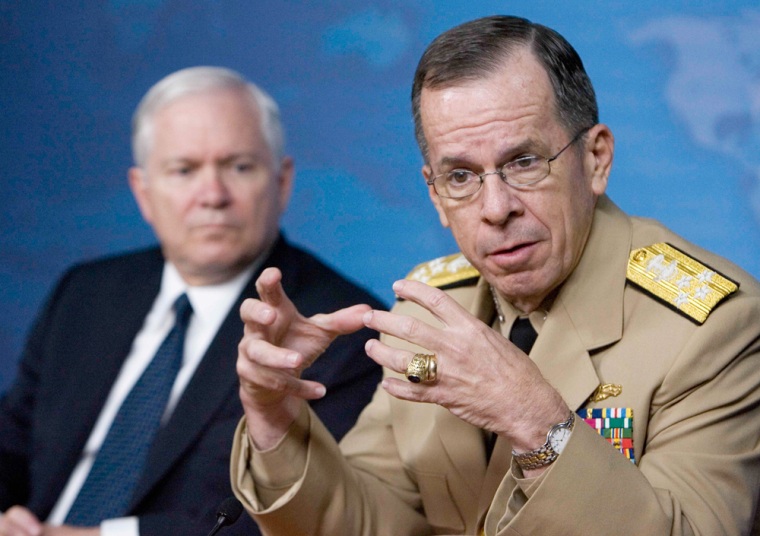Following the official end of the troop surge in Iraq, the Pentagon's top military officer said Wednesday that he expects to be able to recommend further troop reductions in Iraq this fall.
Adm. Mike Mullen, chairman of the Joint Chiefs of Staff, said that on his recent trip to Iraq, he found conditions had improved more than he expected.
"I won't go so far as to say that progress in Iraq from a military perspective has reached a tipping point or is reversible — it has not, and it is not," Mullen told a Pentagon press conference.
"But security is unquestionably and remarkably better. Indeed, if these trends continue I expect to be able early this fall to recommend to the secretary and the president further troop reductions," he said.
His remarks came in the midst of an election year in which Sens. John McCain and Barack Obama, the Republican and Democratic presidential nominees-in-waiting, have disagreed over U.S. strategy in Iraq with the war now in its fifth year.
Surge over
The military surge there that began more than 18 months ago has ended. In recent days, the 3rd Infantry Division's 2nd Brigade, the last of the five additional combat brigades sent in by President Bush last year, left the country.
Its departure marks the end of what the Pentagon calls the "surge." And it starts the 45-day evaluation period that Gen. David Petraeus, the top U.S. commander in Iraq, told Congress he would need to assess the security situation and determine how many more troops he could send home.
Commanders have talked carefully, but somewhat optimistically, about the prospects for cutting troop levels more later this fall.
In recent months, they have pointed to two significant improvements: Violence is down, and the Iraqi forces are rapidly growing in size and ability.
Officials have been hoping that if security continues to improve in Iraq, they may be able to send more units to Afghanistan, where they say violence is increasing because of the flow of militants from neighboring Pakistan.
Defense Secretary Robert Gates said Wednesday that officials are looking for ways to send additional U.S. troops to Afghanistan this year.
For his part, Petraeus remains mum. When questioned by lawmakers in May, he would say only that he is likely to recommend more troop cuts in the fall.
"I do believe there will be certain assets that, as we are already looking at the picture right now, we'll be able to recommend can be either redeployed or not deployed to the theater in the fall," he said.
U.S. force up to 10 percent larger
While there now are technically 13 Army and two Marine combat brigades in Iraq — the same as before the buildup — the force is as much as 10 percent larger than it was in January 2007.
Military officials contend comparisons are not valid because a chunk of the remaining troop bulge is due to units that are overlapping, as two brigades begin moving out of Iraq, while their two replacements move in. The overlap could add up to 6,000 soldiers.
Also, one of the units moving out, the 1st Brigade, 82nd Airborne Division, is much smaller than the one taking its place — the 4th Brigade, 1st Cavalry Division.
So, the officials suggested, the military buildup may not really be over until the transitions are complete.
Mission shift
The key cause for the larger force is the change in mission in Iraq, as the U.S. military is using more trainers, security and support troops to back up the growing Iraqi force. Also, the U.S. units there now are bigger, and they are bolstered by more support forces.
When the military buildup began, there were between 132,000 and 135,000 troops in Iraq. Over time, however, the Pentagon poured troops into Baghdad and the belt of communities that surround it, including the volatile areas of Basra and Sadr City.
With more troops, the military needed more support, including military police to guard detainees and National Guard units to provide security for bases, convoys and other operations.
Earlier this year, military leaders acknowledged that the force in Iraq when the buildup ended would be larger than before it began. And they suggested that the post-buildup force would total about 142,000.
Commanders also have talked carefully, but somewhat optimistically, about the prospects for cutting troop levels more later this fall.
Two significant improvements
In recent months, they have pointed to two significant improvements: Violence is down, and the Iraqi forces are rapidly growing in size and ability.
Last week, Maj. Gen. Michael Oates, commander of the 10th Mountain Division, told Pentagon reporters that the security situation in his area south of Baghdad "is probably the best we've ever seen it."
Oates would not predict any troop cuts, and other military leaders have been reluctant to talk specifics.
